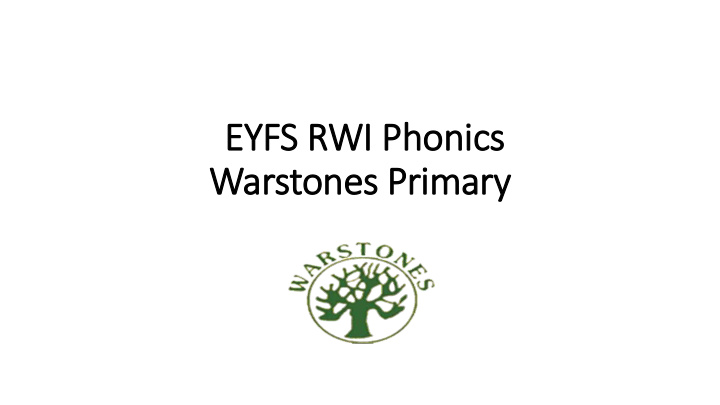



EYFS RWI Phonics Warstones Primary ry
Our aim to day…… • Introduce the way we teach phonics, reading and writing in school, particularly in Early Years. • Share strategies to support your child at home with phonics .
Our Phonics scheme at Warstones Primary School • Aim at the end of Reception • Read storybooks and non-fiction books closely matched to their developing phonic knowledge • Read with fluency and expression • Learn to spell using known sounds • Write confidently by practising what they want to write out loud first • Work well with a partner • Aim at the end of Year 1... • Children are accurate and speedy readers and are ready to move onto our class English lessons One-to-one tutoring - no child is left behind. Storybooks align with the sounds learnt in class. Watch a video clip- ‘Understanding phonics from RWI’
What does Read Write In Inc lo look lik like in in th the cla lassroom? Special friends...2 letters that make 1 sound
Learning to blend and segment with the sounds we know… • Assisted blending as soon as the first 5 sounds are learnt! • Moving towards independent blending. • Fred Fingers for spelling • Say the word and a t c pinch on the sounds • Eyes for reading, fingers for spelling!
Learning to blend and segment with the sounds we know. Green words – contain all the sounds we know. • Fred talk • Fred in your head • No Fred talk Red words ‘If it’s red it’s hard to Fred’ Grotty grapheme!
Reading and writing using RWI phonics • Storybooks or ditties matched to • Get writing books Speed speed sounds • 9 writing activities • 10 minutes lessons Reading spread across the sounds • Recap, learn Writing • 9 reading activities timetable new covering all • Builds up to • Word time aspects spread compositional writing, across the covering all genres timetable Early Years- 30 minutes day, speed sounds and word time. When children are ready they start Ditty books- 1 hour per day.
RWI techniques…some of the things you may hear about! • Praise, praise praise… Positivity and passion… • Firework! All of us want all of the • Round of applause. children to do very well, to enjoy and to achieve! Participation…no passengers! Silent signals…keep the pace! • MTYT • TTYP • Paired work – lolly sticks
Assessment and Monitoring All staff are Read Write Inc trained – differentiated groups across the school Reading is a daily activity as a whole class. Also in Reception class children read once a week 1 to 1 with a teacher/teaching assistant. The importance of 3 reads 1-accuracy 2-building fluency 3-expression, reading like a storyteller Assessment is carried out half termly, any individual concerns are raised.
How to help your child read at home
Reading stories at home Supporting our reading scheme Read favourite stories over and over again It is not a race through levels…there are many skills involved! Children need to be exposed to words several times Read some stories at a higher level than they can read before they become fluent and automatic. themselves. We aim for the children to be able to read as Listen to them reading their take home Phonics storybooks. storytellers with the appropriate expression, intonation and therefore understanding. Watch the RWI storytime at home video on their website for hints and tips. Practise pronouncing the sounds… Have fun with Fred Talk! “What a tidy r -oo- m!” “Where’s your c -oa- t?” Remember no ‘fuh’ and ‘luh’! “Time for b -e- d!”
Available resources How to do all these things and more www.ruthmiskintraining.com/parents
Any Questions?
Recommend
More recommend